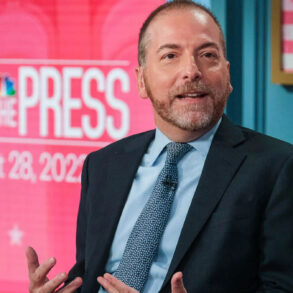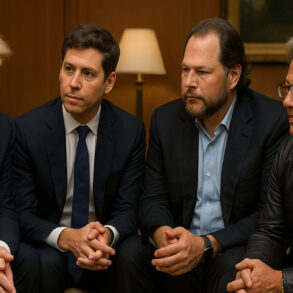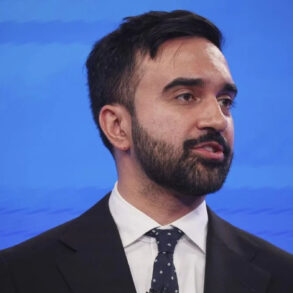President Donald Trump and European Commission President Ursula von der Leyen announced what they both described as the largest trade agreement in world history on July 27, 2025. Valued at over $2.1 trillion, the sweeping deal reshapes the economic relationship between the United States and the European Union, covering energy, manufacturing, automobiles, defense, and agriculture. The agreement impacts nearly a third of all global trade and introduces new tariff structures, investment pledges, and strategic purchases that will shape transatlantic commerce for years to come.
“This is the biggest of them all,” Trump declared at his Turnberry golf resort in Scotland. “We have a deal,” he added, sitting next to von der Leyen as both delegations applauded. Von der Leyen agreed with Trump, calling it “the biggest trade deal ever.”
Averting a Trade War
This agreement comes just days before a deadline that could have sparked a full-scale trade war. In early July, Trump had threatened to impose tariffs as high as 50 percent on nearly all goods entering the United States from the European Union. That threat had created panic among European leaders and exporters, especially after Trump reduced the proposed rate to 30 percent in a letter sent to von der Leyen on July 12.
German Chancellor Friedrich Merz acknowledged that the deal helped avoid serious damage. “It averted an unnecessary escalation in transatlantic trade relations,” he said, adding that a trade conflict “would have hit Germany’s export-oriented economy hard.”
The final agreement includes a 15 percent tariff on most European products entering the U.S., replacing the previously higher rates on goods like automobiles. The European Union, in return, will invest $600 billion into the U.S. economy and commit to purchasing $750 billion worth of American energy products during Trump’s current term.
“This started months ago, this negotiation, so we knew what we were getting into,” Trump said. “It’s a giant deal with lots of countries,” referring to the EU’s 27 member states. He also described the EU as having been “essentially closed” to American goods in the past and said, “You weren’t exactly taking our orders. You weren’t exactly taking our agriculture.”
Tariff Reductions and Key Terms
The agreement introduces sweeping tariff changes. Before this deal, most European products entering the U.S. faced average tariffs of only about 1.5 percent. Automobiles, in particular, had been subject to a 27.5 percent tariff. Under the new deal, those tariffs will be capped at 15 percent.
Cars and car parts, long a source of friction between the two economies, will now face this lower rate. This provides a measure of relief for European automakers. Volkswagen, for example, reported a $1.5 billion loss in the first half of 2025 because of the earlier tariffs.
Steel and aluminum, however, will still face a 50 percent tariff. Trump explained that this was “a worldwide thing,” and not specific to Europe. Von der Leyen acknowledged that discussions would continue, saying that tariffs on metals might eventually be replaced by a quota system.
Some categories will be excluded from tariffs altogether. These include aircraft and component parts, certain chemicals, some generic drugs, semiconductor manufacturing equipment, and selected agricultural and natural resource products.
Pharmaceuticals and microchips will have zero tariffs until the U.S. concludes investigations under Section 232. According to U.S. officials, these products will never face tariffs above 15 percent even after the investigations are completed.
However, the treatment of other goods is still undecided. Wine and spirits, for example, remain in limbo, and the final rate has not been agreed upon.
Strategic Purchases and Investments
In one of the deal’s most significant elements, the EU agreed to make $750 billion in strategic purchases from the United States. This includes oil, natural gas, nuclear technology, and microchips. Von der Leyen confirmed that the EU would spend an additional $250 billion per year through the end of Trump’s term.
“This is a massive commitment that will benefit American energy producers and reduce Europe’s dependence on adversarial sources like Russia,” a senior U.S. official said.
The EU also promised $600 billion in direct investments into the U.S., which will come from private European companies and public agencies. These investments are expected to cover infrastructure, manufacturing, and research sectors.
Trump said, “They’re agreeing to purchase a vast amount of military equipment. We don’t know what that number is, but the good news is we make the best military equipment in the world, so you’ve sort of got to do that, until somebody tops us, which is not going to happen.”
What Europe Gained and Lost
European leaders had hoped to secure a zero-for-zero tariff agreement. That would have eliminated most trade barriers. Instead, they accepted a 15 percent across-the-board rate. Some European officials were quick to express disappointment.
François Bayrou, France’s Prime Minister, called it “a dark day for Europe.” He added, “The bloc has caved in to the U.S. president with an unbalanced deal that spares U.S. imports from any immediate European retaliation.”
Bernd Lange, a German member of the European Parliament, said, “My initial assessment: Not satisfactory. This is a lopsided deal.”
The Federation of German Industries warned that the new tariff rates “will have immense negative effects on export-oriented German industry.”
Others, however, praised the agreement for bringing clarity. Dutch Foreign Trade Minister Hanneke Boerma described the deal as “not ideal” but necessary to avoid chaos.
Von der Leyen defended the pact by saying, “You can call it fairness, you can call it rebalancing. We have a surplus and the United States has a deficit, and we have to rebalance it.”
Trump’s Trade Strategy
This agreement is the latest in a string of international trade deals Trump has secured in recent months. Earlier this year, he struck new agreements with Japan, the United Kingdom, the Philippines, Indonesia, and China. Each of those deals included commitments to reduce trade imbalances and increase U.S. exports.
Commerce Secretary Howard Lutnick said, “President Trump just unlocked one of the biggest economies in the world. The European Union is going to open its $20 trillion market and completely accept our auto and industrial standards for the first time ever.”
Economists remain divided. Carsten Brzeski of ING Research said the agreement is “damage control” that prevented a worse outcome. “When you prepare for a hurricane, somehow the storm feels like a relief,” he said.
Still, many analysts believe the tariffs will increase prices for U.S. consumers. Wolfgang Niedermark of Germany’s industry federation said, “Even a 15 percent tariff rate will have huge negative impact.” Holger Schmieding of Berenberg Bank added, “The crippling uncertainty is largely over, the deal is bearable for the EU. Trump can claim it as a win. But the outcome is still bad relative to the situation that prevailed before Trump started his trade wars.”
Much of the fine print still has to be worked out. European ambassadors will be discussing the deal with the Commission this week. A full paper outlining the specific terms is expected soon, along with lists of exempted products and quotas for items like steel and aluminum.
There is also concern in Europe that Trump could change the terms later. A senior U.S. official confirmed that Trump retains the authority to increase tariffs if European countries fail to follow through on their investment promises.
Despite the questions that remain, both sides emphasized the historic nature of the agreement. The deal impacts a third of the global economy and touches nearly every major industry. For Trump, it is another piece of what he calls his “America First” trade legacy.
“This is a satisfactory deal for both the EU and the United States,” Trump said. “It’s good for business, good for workers, and good for peace between two great economies.”








